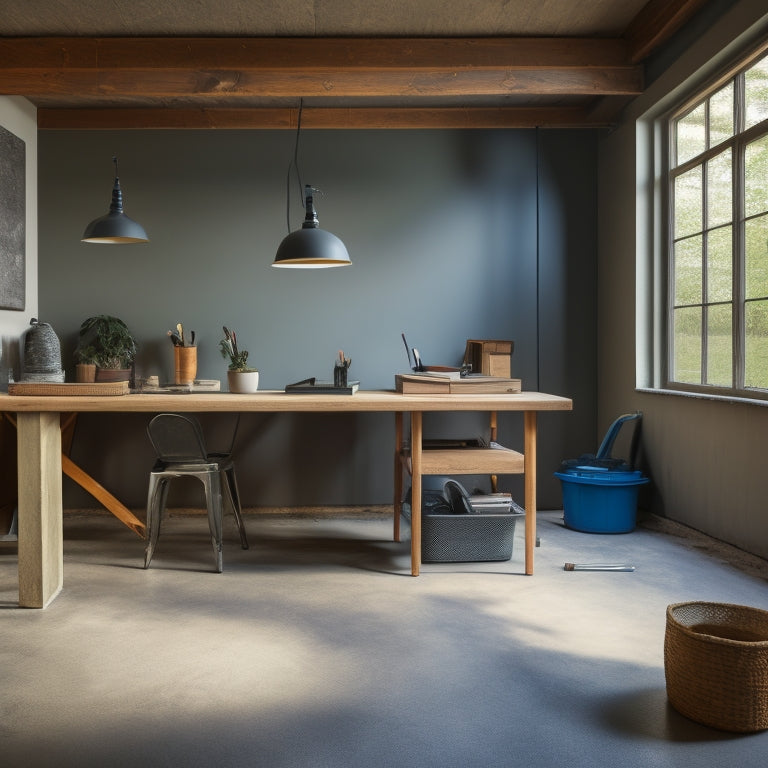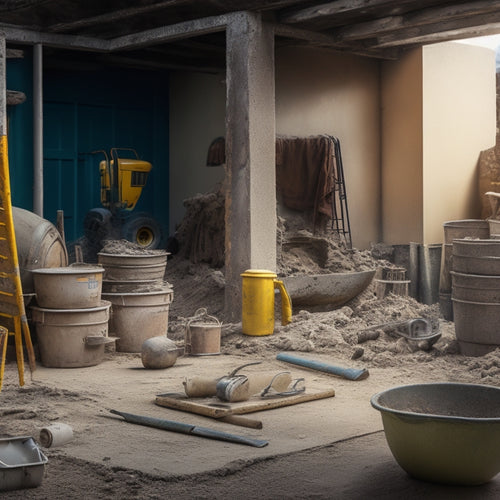
7 Must-Have Tools for Perfect Concrete Finish
Share
You'll need seven must-have tools to achieve a perfect concrete finish. First, an edger creates clean cuts and defined edges. A tamping tool guarantees flat surfaces by flattening and smoothing concrete. A concrete float removes excess water and air pockets for a stronger finish. A power trowel transforms smooth concrete into high-gloss finishes. A concrete grinder prepares surfaces by removing imperfections. A broom enables control over texture and pattern, while a curing compound applicator ensures uniform distribution of the curing agent. With these tools, you'll be well on your way to creating professional-looking concrete finishes - and there's more to discover about mastering each tool's techniques and best practices.
Key Takeaways
• Having the right tools is crucial for achieving a perfect concrete finish, with each tool serving a specific purpose in the finishing process.
• Edgers, tamping tools, and concrete floats are essential for creating clean cuts, flat surfaces, and smooth finishes.
• Power trowels, concrete grinders, and brooms are necessary for high-gloss finishes, surface preparation, and texture creation.
• Using the right tool for the job can ensure professional-looking results, prevent defects, and enhance safety on the job site.
• Mastering various techniques and safety protocols is vital for achieving optimal results with each tool and ensuring a successful concrete finishing project.
Edger for Clean Cuts
When working with concrete, an edger is vital for creating clean cuts and defined edges, allowing you to achieve a professional-looking finish with precise control.
You'll find that there are several edger types to choose from, each suited for specific tasks. For example, a walk-behind edger is ideal for large, flat areas, while a handheld edger is better for smaller, more intricate cuts.
To get the most out of your edger, it's important to master various edging techniques. One popular method is to use a slow, gentle motion to create a clean, defined edge. Another technique is to use a series of shallow cuts to remove excess concrete and achieve a smooth finish.
Regardless of the technique you choose, make certain to always wear protective gear, including gloves, safety glasses, and a dust mask. This will help prevent injuries and guarantee a safe, successful concrete finishing experience.
Tamping Tool for Flat Surfaces
When you're working on flat surfaces, a tamping tool is essential to achieve a perfect concrete finish.
You'll appreciate how this tool helps you secure even surfaces, making it easy to operate and giving you precise control over the final result.
With a tamping tool, you'll be able to guarantee a flawless finish that meets your high standards.
Even Surfaces Guaranteed
You can guarantee even surfaces by using a tamping tool, which is specifically designed to flatten and smooth out concrete surfaces. This essential tool helps eliminate surface imperfections, ensuring a professional finish.
When you use a tamping tool, you're employing advanced smoothing techniques to achieve a flawless concrete surface. By compacting the concrete, you're removing any air pockets and excess water, resulting in a strong and durable finish.
To get the most out of your tamping tool, make sure to use it at the right stage of the concrete's setting process. Typically, this is when the concrete has reached its initial set, but is still pliable.
At this stage, the tamping tool can effectively smooth out the surface, removing any imperfections and bubbles. Remember to work in sections, using long, even strokes to cover the entire area.
Easy to Operate
Operating the tamping tool for flat surfaces is a straightforward process that requires minimal effort and expertise. You'll appreciate the user-friendly features designed to make your job easier and safer.
The ergonomic handle, for instance, fits comfortably in your hand, reducing fatigue and strain. Additionally, the adjustable handle height allows you to work at a comfortable stance, minimizing the risk of injury.
As a beginner, you'll appreciate the beginner tips that come with the tool. The instructional guide provides clear, step-by-step instructions on how to assemble, operate, and maintain the tamping tool.
It also includes valuable tips on how to achieve the perfect concrete finish. With the tamping tool, you can focus on achieving a smooth, even surface without worrying about the complexity of the tool itself.
The tool's simplicity and ease of use guarantee that you can complete your project efficiently and effectively, without compromising on quality or safety.
Precise Control Achieved
Achieving precise control over the tamping process is made possible by the tool's adjustable handle and precisely engineered tamper head, allowing you to expertly regulate the amount of pressure and speed needed to attain a flawless concrete finish. This level of precision measurement enables you to tailor your finishing techniques to specific project requirements, guaranteeing a high-quality outcome.
With the tamper's adjustable handle, you can customize the tool to fit your comfort and working style, reducing fatigue and improving overall control. The tamper head's precision engineering guarantees consistent results, even on large or complex projects. By achieving precise control, you'll be able to identify and correct any imperfections early on, saving time and resources in the long run.
When it comes to finishing techniques, precise control is essential for achieving a smooth, even surface. By regulating the amount of pressure and speed, you can prevent over- or under-tamping, which can lead to defects and safety hazards.
With the right tool and techniques, you'll be able to deliver high-quality results while maintaining a safe working environment.
Concrete Float for Smooth Finishing
A concrete float's flat, broad blade glides effortlessly across the freshly poured surface, expertly spreading and flattening the mixture to create a smooth, even base for further finishing.
As you work with a concrete float, you'll notice how it helps to remove excess water and air pockets, resulting in a stronger, more durable concrete finish.
There are various float types to choose from, including bull floats, fresno floats, and darby floats, each designed for specific finishing techniques and surface textures.
When selecting a float, consider the size of your project, the type of concrete you're working with, and the desired finish. For example, a bull float is ideal for large, open areas, while a fresno float is better suited for smaller, more confined spaces.
Power Trowel for High-Gloss Finish
With a power trowel, you'll be able to transform your smooth concrete base into a high-gloss finish that's both durable and visually stunning. This versatile tool is designed to apply high pressure, allowing you to achieve a polished finish that's perfect for high-traffic areas or decorative surfaces.
To get the most out of your power trowel, it's important to master the right techniques. Start by adjusting the trowel's speed and angle to suit the concrete's moisture level and your desired finish. Then, use overlapping passes to cover the entire surface, maintaining consistent pressure and direction.
Regular power trowel maintenance is also vital to guarantee peak performance and extend the tool's lifespan. Clean the trowel regularly to prevent concrete buildup, and store it in a dry place to prevent rust. Additionally, inspect the blades for wear and tear, replacing them as needed.
Concrete Grinder for Surface Prep
Before applying a high-gloss finish, you need to confirm the concrete surface is properly prepared, which is where a concrete grinder comes into play, allowing you to efficiently remove imperfections and create a smooth canvas for finishing.
There are various concrete grinder types to choose from, including walk-behind, ride-on, and handheld models, each suited for specific surface prep tasks. For instance, walk-behind grinders are ideal for large areas, while handheld grinders are perfect for tight spaces and edges.
When it comes to surface prep techniques, you'll want to evaluate the level of aggression required for your project. Light grinding may be sufficient for minor imperfections, while more aggressive grinding may be needed for deeply pitted or damaged surfaces.
Regardless of the technique, always prioritize safety by wearing personal protective equipment, including gloves, safety glasses, and a dust mask. Additionally, verify the grinder is properly maintained and operated to avoid accidents and achieve the best results.
Broom for Texture and Pattern
When you're working with concrete, you're likely looking for ways to control the texture and create unique patterns.
With a broom, you can achieve a range of textures, from smooth to rough, and even create custom patterns that add visual interest to your finished product.
Texture Control Options
You can achieve a range of textures and patterns on your concrete surface by employing various broom finishes, each producing a distinct visual effect.
When it comes to texture control options, you'll want to master different broom techniques to attain the desired finish style. One common method is the 'broom drag' technique, where you pull the broom in a consistent, smooth motion to create a uniform texture. Another popular option is the 'broom swirl' technique, which involves moving the broom in a circular motion to create a more decorative pattern.
To guarantee a safe and successful finish, it's crucial to choose the right broom for the job. Look for brooms with sturdy handles and durable bristles that can withstand the rigors of concrete finishing.
Additionally, make sure to follow proper safety protocols, such as wearing protective gear and working in a well-ventilated area.
Pattern Variety Achieved
With a range of broom techniques under your belt, you can now explore the vast pattern variety achievable with the right broom and finishing skills.
From subtle textures to intricate designs, a well-chosen broom can elevate your concrete finish to the next level. To achieve the perfect pattern, consider the type of broom head, bristle length, and angle of attack. For instance, a broom with stiff bristles can create a more aggressive texture, while a broom with softer bristles will produce a smoother finish.
When combined with pattern stamping and decorative overlays, the possibilities become endless. You can create complex patterns, mimic natural stone, or even achieve a unique, one-of-a-kind look.
Remember to always work safely, wearing protective gear and following established best practices to avoid accidents and injuries.
Curing Compound Applicator
A curing compound applicator guarantees uniform distribution of the curing agent across the freshly poured concrete surface, allowing for a more efficient and effective curing process.
As you work on perfecting your concrete finish, you'll want to verify that your curing techniques are on point. With a curing compound applicator, you can rest assured that your application methods are consistent and reliable.
Here are some key benefits of using a curing compound applicator:
-
Efficient coverage: The applicator guarantees that the curing agent is evenly distributed, saving you time and effort.
-
Reduced waste: With precise application, you'll minimize excess curing agent and reduce waste.
-
Improved finish: Uniform distribution of the curing agent leads to a smoother, more even finish.
- Enhanced safety: By reducing the risk of over- or under-application, you'll create a safer working environment.
Frequently Asked Questions
Can I Use a Single Tool for Both Tamping and Floating Concrete?
When working with concrete, you might wonder if you can use a single tool for both tamping and floating.
While it's technically possible, it's not the most effective or safe approach. Tamping techniques require a tool that can apply high pressure, whereas floating methods need a tool that can smoothly even out the surface.
Using one tool for both can compromise the quality of your finish and even lead to accidents. It's better to use separate tools designed for each task to guarantee a perfect finish and your safety on the job site.
How Often Should I Clean and Maintain My Concrete Finishing Tools?
Don't let your tools become a liability - after all, a clean tool is a safe tool!
You should clean and maintain your concrete finishing tools regularly to extend their tool lifespan. Aim to clean your tools daily, and perform deeper maintenance every week.
This frequency will prevent rust, reduce wear, and guarantee your tools remain in top condition.
Are There Any Safety Precautions for Using Power Trowels on Concrete?
When operating a power trowel on concrete, you must prioritize safety.
Always wear personal protective equipment (PPE) like gloves, safety glasses, and a dust mask to prevent injuries.
Verify the power trowel is properly maintained and in good condition to avoid accidents.
Keep a safe distance from others and avoid overreaching or bending, which can lead to loss of control.
Can I Use a Broom With Synthetic Bristles for Creating Texture Patterns?
Are you wondering if you can achieve the perfect texture pattern with a broom?
You can use a broom with synthetic bristles to create texture patterns on your concrete surface. Synthetic bristles are a great option as they're less likely to absorb water, reducing the risk of inconsistent textures.
Simply dip the broom in water, and then drag it across the concrete to create the desired pattern. This method allows for a high level of control and flexibility, ensuring a professional-looking finish.
Do I Need to Apply Curing Compound to All Types of Concrete Finishes?
When it comes to curing compound, you're not required to apply it to all types of concrete finishes.
However, you should use it for most concrete types, especially those that need protection from the elements.
Curing techniques vary, but for standard concrete, applying a curing compound is essential to prevent moisture loss and guarantee proper strength development.
Conclusion
With these 7 must-have tools in your arsenal, you'll be unstoppable in achieving a perfect concrete finish.
From clean cuts to high-gloss surfaces, each tool plays an essential role in the process.
Don't even think about starting a project without them - it's like trying to build a skyscraper without a foundation!
With the right tools, you'll be able to tackle even the most complex projects with confidence and precision.
Related Posts
-

Why You Need Affordable Concrete Wall Construction Tools
You need affordable concrete wall construction tools to guarantee a profitable project, as the cost of equipment can ...
-

Top Mixing Tools for DIY Concrete Block Laying
When it comes to DIY concrete block laying, the right mixing tools are vital for a strong and durable structure. You'...
-

What Tools Are Needed for Concrete Wall Foundations
You'll need a thorough array of tools and equipment to construct a concrete wall foundation that meets structural int...


